Curing the Bends
(Installing Corvette Seats in a Pantera for Medicinal Purposes)
Story and Photographs by David Bell
The Disease
The bends are evil. For the first year and a half that I’d owned the Pantera, I’d ended up with an ugly case of the bends every time I’d driven it. No matter how hard I tried to sit upright, my bum (proper English for ‘butt’) would slide forward in that spoon-shaped seat bottom until my knees hit the steering column. My legs would then get all crinkled up uncomfortably against the dash. I could straighten up temporarily only to end up in the same position again 30 seconds later. It was sort of like trying to eat Cheerios for breakfast with a hangover. No matter what you do, those Cheerios will keep slipping off the spoon back into the bowl. So after pulling myself upright in the seat 10 or 12 times I’d eventually give up and, like the Cheerios, slide off the spoon into the milk and just stay there. Then I’d have to drive the rest of the way all kink-knee’d.
But as uncomfortable as the drive might be, the real difficulty was getting out of the car gracefully at the end of the drive. The knee joints of Homo Sapiens were not designed to be locked in a collapsed position for 45 minutes and then moved suddenly. An additional 45 minutes are required for gradual decompression. Otherwise the knee joint will explode like one of those deep-water fish that gets yanked up to the surface too quickly. Then the wife gets to explain to everyone at the party why you’re still sitting in the car drinking beer all alone. The bends are evil – and embarrassing.
So maybe you can understand now that I hated those stock Pantera seats.
Sure, I know they’re approaching 30 years old and had lasted much longer than could be reasonably expected. More than likely the now squashed foam and tired vinyl upholstery was original. Probably they could be reconditioned to better than new – in leather no less. I knew of plenty of Pantera owners that were perfectly happy with the stock seats. But I was fed up - I hated those seats. After a year and a half of the bends, I was ready to try something else.
The Diagnosis
Fortunately my wife Marilyn recognized my symptoms in time and volunteered to buy me a pair of Corvette seats as a birthday present. I’d heard from several Pantera guys that C-4 Corvette seats were a nice fit in a Pantera but as I’d never owned a Corvette, I wasn’t at all familiar with C-4 seats (note: C-4 in this context is the Corvette built between 1984 and 1996, not the plastic explosive used to blow up bank vaults and rural mailboxes).
But I got lucky at the 2001 Texas World Speedway track event. I was able to actually sit in a couple of Corvettes and personally try out two different versions of C-4 seats. I found that the Corvette seats were extremely comfortable, multi-adjustable including seatback rake, and they had nice side bolsters to hold you in place at speed. I also thought that the style would go well with the rest of stock Pantera interior.
So I spent the next 6 weeks shopping E-Bay for a pair of C-4 Corvette seats. There were a variety of Corvette seat styles used in different years but I wasn’t especially set on any particular version. My requirements were that the seats had to be black, they had to be leather, and they had to be under $500. For a while I was afraid the C-4 seats were all too expensive - $700 and up. But out of necessity, I was patient. I set up a ‘Corvette Seat’ watch within E-Bay that would notify me every time a different set of Corvette seats showed up for auction. Then I waited.
Eventually I found a nearly perfect pair that was extracted from a low mileage ’96 C-4 wreck. My winning bid was $350, plus an extra $65 for two manual seat tracks and a 6-way electric track w/harness and seat control switch, plus another $35 for shipping. The total for the pair of seats delivered to my door was a very reasonable $450 – less than I would have had to pay to have only one of my original seats restored.
Now I just had to install them. Maybe easier said than done.
The Treatment
After removing my stock seats, I was able to compare the Corvette seats to the Pantera seats side-by-side in the driveway. The Corvette seats without the tracks were about a half an inch taller than the stocks seats with the tracks.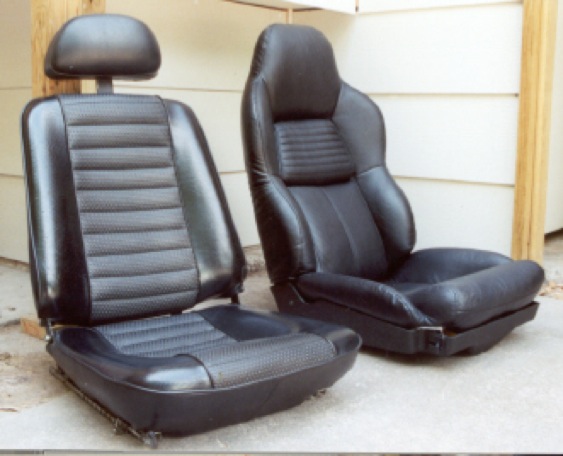
Adding the seat tracks raised the Corvette seats another 2 inches. I had had plenty of headroom with the stock seats but clearly the C-4 seat height was going to be marginal at best in a Pantera. But the C-4 tracks themselves had a curved upper surface so that the seat would be somewhat lower when in a rearward position. Since I have long legs and the seats would be normally positioned rearward, I decided to go ahead and install them – hoping I could avoid any major modifications.
First I positioned the electric track over the existing holes in the floor pan. The stock holes in floor pan lined up exactly with the front holes in the electric track. But two new holes had to be drilled about two inches closer to the firewall to mount the rear of the electric track. Then I wired up the electric track using a 12-volt power lead from my battery charger and adjusted the seat track as low and as far rearward as possible. Next I dropped the seat in place and crawled in. Oops. The seat itself felt great but my head was seriously into the headliner. Any movement of the seat (tilt, up, forward) raised my head even higher. Worse, the electric track itself could not be easily modified as it was constructed as a rectangular metal unit which incases the three motors that operate the seat. Short of cutting and dropping the stock floor pans, the electric track wasn’t going to work.
That’s OK. The manual tracks had the same bolt pattern as the electric track and they seemed to be slightly shorter. I could do without the seat bottom tilt provided by the electric track. In went one of the manual tracks. Bolt on the seat. Try the seating position. Hmmm. Definitely better than the electric track but still too far on the tall side. By playing around with the rake adjustment I eventually got the height tolerable. So I decided to also install the passenger seat and then road test the seats for a week or so. After a few days of driving back and forth to work (20 miles) though, I realized that the seats really needed to be dropped down at least an inch. Because of the extra height of the seat bottom, my thighs ended up so close to the steering wheel that they occasionally interfered with normal driving motions. Back to the drawing board.
The Cure
Both C-4 seats were removed and disassembled. The manual tracks for one seat consist of two nearly matching pieces (left side and right side) constructed of heavy gauge sheet metal. Each track half is formed with a long extension on front and a short leg on the rear. The left track half contains the lever mechanism that permits the seat to slide forward and backward while the seat-back rake control is on the seat itself. The front legs of the tracks have a 90-degree bend at the base that forms a small horizontal platform that serves at the attachment point with the floor pan (where the front bolt passes through). The rear of the tracks really has hardly any leg at all. Instead, the lower track-sliding surface is merely bent down then back up slightly at the end, parallel to the floor pan.
Assisted by Fred Hall in the operating room, the tracks were shortened 1 ½ inches by removing a strip of metal from each of the four front track legs with a cutting torch (a die grinder or hacksaw would also work). The metal was removed as a section between the bottom of the seat track and the base of the leg. The base of the leg (with the horizontal mounting platform) was then rotated 180 degrees and welded back onto the track in the form of a box using a mig welder bummed from Fred Hall (as was the cutting torch). I had to be careful to leave enough clearance to allow the floor-mounting bolt to pass by the track above it. I also had to use an allen-head mounting bolt as there wasn’t enough room to tighten a normal hex-head.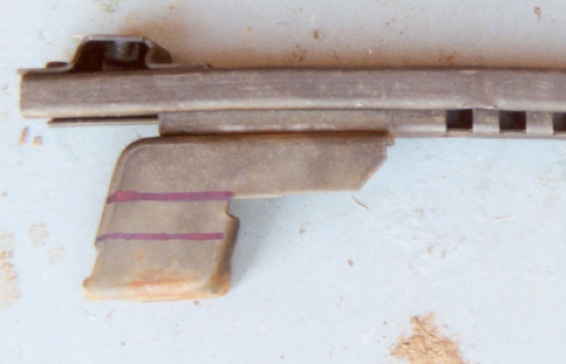
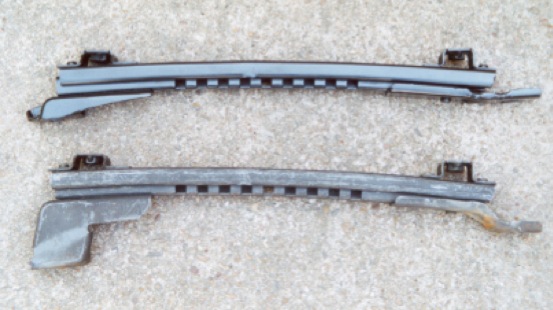
The rear of the track was shortened about ¾ inch by notching the side ridges with a hacksaw, and then heating and hammering the stubby track leg flatter. After flattening the rear of the track, the sawed notches were welded back shut for strength. Since effectively the track runner had been lengthened slightly by flattening it out, the rear bolthole in the track was no longer aligned with the hole in the floor pan. Slotting the existing rear track hole forward with a rotary grinding bit and an electric drill solved that problem.
A little additional clearance was gained by cutting away carpet and insulation in the areas where the seat tracks would contact the floor pan. The area was marked with a felt pen and the carpet was cut very carefully with a razor knife. A couple of spare bolts were coated with anti-seize and inserted into the stock rear seat track mounting holes in the floor pan, which were now unused.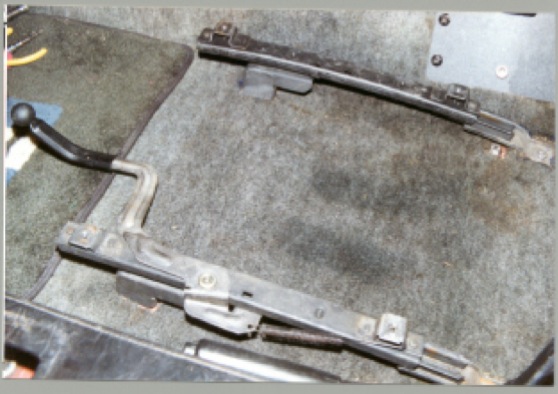
After a coat of black paint to cover the welding and grinding marks, the driver’s side seat went back in. Excellent. Now my head was far enough away from the headliner to permit wearing a helmet for track events. And the C-4 seat was very comfortable with good lateral support plus it had the added bonus of a rake adjustment – a huge improvement over my tired stock seat. The fit of the seat within the narrow Pantera passenger compartment was perfect. The new seat even nicely matched my existing interior in terms of both color and style.
A short drive down the freeway convinced me that I’d just made a gigantic improvement in driving comfort. The only other modification was to insert a pair of ½ inch thick spacers (from the stock Pantera seats) under the base of the front tracks to tilt the front of seat bottom up a little more.
Then I went through the same process for the passenger side seat.
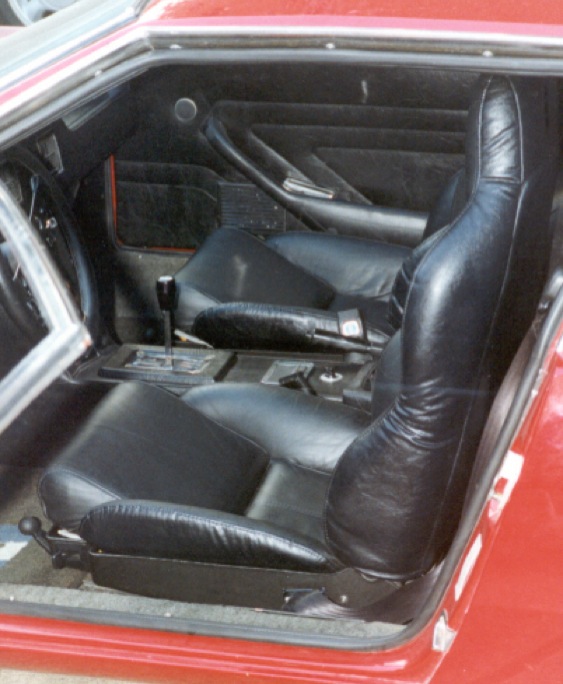
The End
My name is David Bell and I’m recovering from the bends. But I’ve been straight now for over two months and I haven’t had a single attack during that entire time.
A couple of nights ago my wife Marilyn and I were late for a movie. I parked the Pantera, jumped out, and then incredibly was able to walk briskly to the box office without passersby thinking I was doing a Chester impersonation (you know, the gimpy deputy on Gunsmoke). And I don’t have to drink beer in the car all alone at parties any more. Even my wife is starting to think I might be cured. For the first time in over a year and a half, I’m beginning to realize that there is a better life out there. And maybe the bends isn’t terminal after all.
Isn’t modern medical technology amazing?


